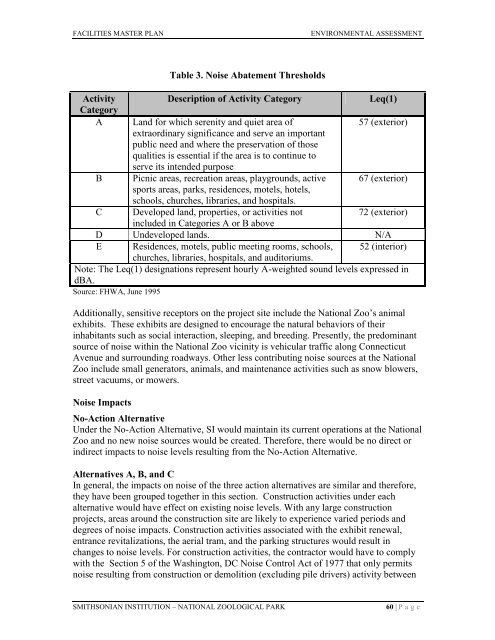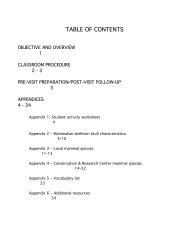facilities renewal master plan - National Zoo - Smithsonian Institution
facilities renewal master plan - National Zoo - Smithsonian Institution
facilities renewal master plan - National Zoo - Smithsonian Institution
Create successful ePaper yourself
Turn your PDF publications into a flip-book with our unique Google optimized e-Paper software.
FACILITIES MASTER PLAN ENVIRONMENTAL ASSESSMENT<br />
Table 3. Noise Abatement Thresholds<br />
Activity<br />
Category<br />
Description of Activity Category Leq(1)<br />
A Land for which serenity and quiet area of<br />
extraordinary significance and serve an important<br />
public need and where the preservation of those<br />
qualities is essential if the area is to continue to<br />
serve its intended purpose<br />
57 (exterior)<br />
B Picnic areas, recreation areas, playgrounds, active<br />
sports areas, parks, residences, motels, hotels,<br />
schools, churches, libraries, and hospitals.<br />
67 (exterior)<br />
C Developed land, properties, or activities not<br />
included in Categories A or B above<br />
72 (exterior)<br />
D Undeveloped lands. N/A<br />
E Residences, motels, public meeting rooms, schools,<br />
churches, libraries, hospitals, and auditoriums.<br />
52 (interior)<br />
Note: The Leq(1) designations represent hourly A-weighted sound levels expressed in<br />
dBA.<br />
Source: FHWA, June 1995<br />
Additionally, sensitive receptors on the project site include the <strong>National</strong> <strong>Zoo</strong>’s animal<br />
exhibits. These exhibits are designed to encourage the natural behaviors of their<br />
inhabitants such as social interaction, sleeping, and breeding. Presently, the predominant<br />
source of noise within the <strong>National</strong> <strong>Zoo</strong> vicinity is vehicular traffic along Connecticut<br />
Avenue and surrounding roadways. Other less contributing noise sources at the <strong>National</strong><br />
<strong>Zoo</strong> include small generators, animals, and maintenance activities such as snow blowers,<br />
street vacuums, or mowers.<br />
Noise Impacts<br />
No-Action Alternative<br />
Under the No-Action Alternative, SI would maintain its current operations at the <strong>National</strong><br />
<strong>Zoo</strong> and no new noise sources would be created. Therefore, there would be no direct or<br />
indirect impacts to noise levels resulting from the No-Action Alternative.<br />
Alternatives A, B, and C<br />
In general, the impacts on noise of the three action alternatives are similar and therefore,<br />
they have been grouped together in this section. Construction activities under each<br />
alternative would have effect on existing noise levels. With any large construction<br />
projects, areas around the construction site are likely to experience varied periods and<br />
degrees of noise impacts. Construction activities associated with the exhibit <strong>renewal</strong>,<br />
entrance revitalizations, the aerial tram, and the parking structures would result in<br />
changes to noise levels. For construction activities, the contractor would have to comply<br />
with the Section 5 of the Washington, DC Noise Control Act of 1977 that only permits<br />
noise resulting from construction or demolition (excluding pile drivers) activity between<br />
SMITHSONIAN INSTITUTION – NATIONAL ZOOLOGICAL PARK 60 | P a g e

















